2006 MERCEDES-BENZ SPRINTER engine
[x] Cancel search: enginePage 2281 of 2305
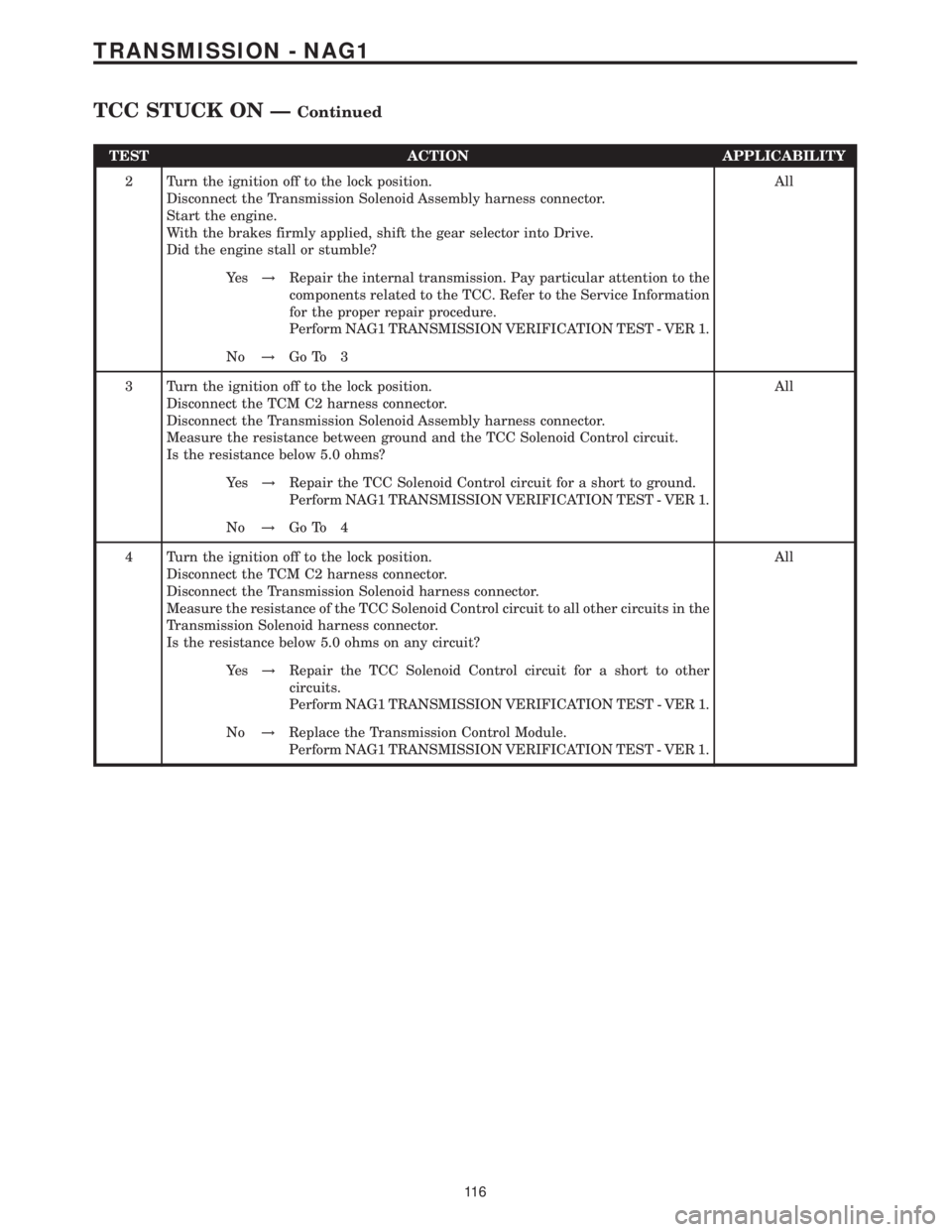
TEST ACTION APPLICABILITY
2 Turn the ignition off to the lock position.
Disconnect the Transmission Solenoid Assembly harness connector.
Start the engine.
With the brakes firmly applied, shift the gear selector into Drive.
Did the engine stall or stumble?All
Ye s!Repair the internal transmission. Pay particular attention to the
components related to the TCC. Refer to the Service Information
for the proper repair procedure.
Perform NAG1 TRANSMISSION VERIFICATION TEST - VER 1.
No!Go To 3
3 Turn the ignition off to the lock position.
Disconnect the TCM C2 harness connector.
Disconnect the Transmission Solenoid Assembly harness connector.
Measure the resistance between ground and the TCC Solenoid Control circuit.
Is the resistance below 5.0 ohms?All
Ye s!Repair the TCC Solenoid Control circuit for a short to ground.
Perform NAG1 TRANSMISSION VERIFICATION TEST - VER 1.
No!Go To 4
4 Turn the ignition off to the lock position.
Disconnect the TCM C2 harness connector.
Disconnect the Transmission Solenoid harness connector.
Measure the resistance of the TCC Solenoid Control circuit to all other circuits in the
Transmission Solenoid harness connector.
Is the resistance below 5.0 ohms on any circuit?All
Ye s!Repair the TCC Solenoid Control circuit for a short to other
circuits.
Perform NAG1 TRANSMISSION VERIFICATION TEST - VER 1.
No!Replace the Transmission Control Module.
Perform NAG1 TRANSMISSION VERIFICATION TEST - VER 1.
11 6
TRANSMISSION - NAG1
TCC STUCK ON ÐContinued
Page 2282 of 2305
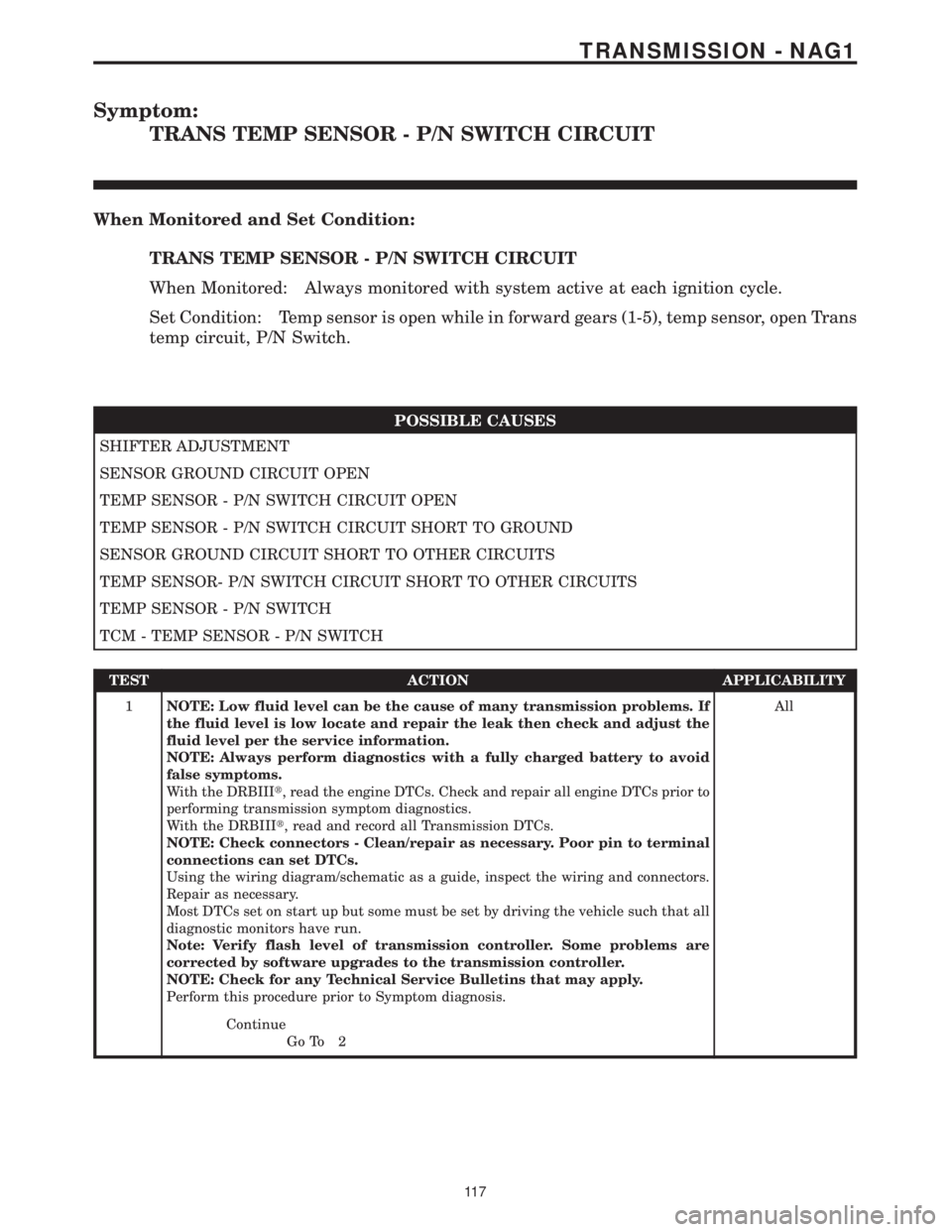
Symptom:
TRANS TEMP SENSOR - P/N SWITCH CIRCUIT
When Monitored and Set Condition:
TRANS TEMP SENSOR - P/N SWITCH CIRCUIT
When Monitored: Always monitored with system active at each ignition cycle.
Set Condition: Temp sensor is open while in forward gears (1-5), temp sensor, open Trans
temp circuit, P/N Switch.
POSSIBLE CAUSES
SHIFTER ADJUSTMENT
SENSOR GROUND CIRCUIT OPEN
TEMP SENSOR - P/N SWITCH CIRCUIT OPEN
TEMP SENSOR - P/N SWITCH CIRCUIT SHORT TO GROUND
SENSOR GROUND CIRCUIT SHORT TO OTHER CIRCUITS
TEMP SENSOR- P/N SWITCH CIRCUIT SHORT TO OTHER CIRCUITS
TEMP SENSOR - P/N SWITCH
TCM - TEMP SENSOR - P/N SWITCH
TEST ACTION APPLICABILITY
1NOTE: Low fluid level can be the cause of many transmission problems. If
the fluid level is low locate and repair the leak then check and adjust the
fluid level per the service information.
NOTE: Always perform diagnostics with a fully charged battery to avoid
false symptoms.
With the DRBIIIt, read the engine DTCs. Check and repair all engine DTCs prior to
performing transmission symptom diagnostics.
With the DRBIIIt, read and record all Transmission DTCs.
NOTE: Check connectors - Clean/repair as necessary. Poor pin to terminal
connections can set DTCs.
Using the wiring diagram/schematic as a guide, inspect the wiring and connectors.
Repair as necessary.
Most DTCs set on start up but some must be set by driving the vehicle such that all
diagnostic monitors have run.
Note: Verify flash level of transmission controller. Some problems are
corrected by software upgrades to the transmission controller.
NOTE: Check for any Technical Service Bulletins that may apply.
Perform this procedure prior to Symptom diagnosis.All
Continue
Go To 2
11 7
TRANSMISSION - NAG1
Page 2285 of 2305
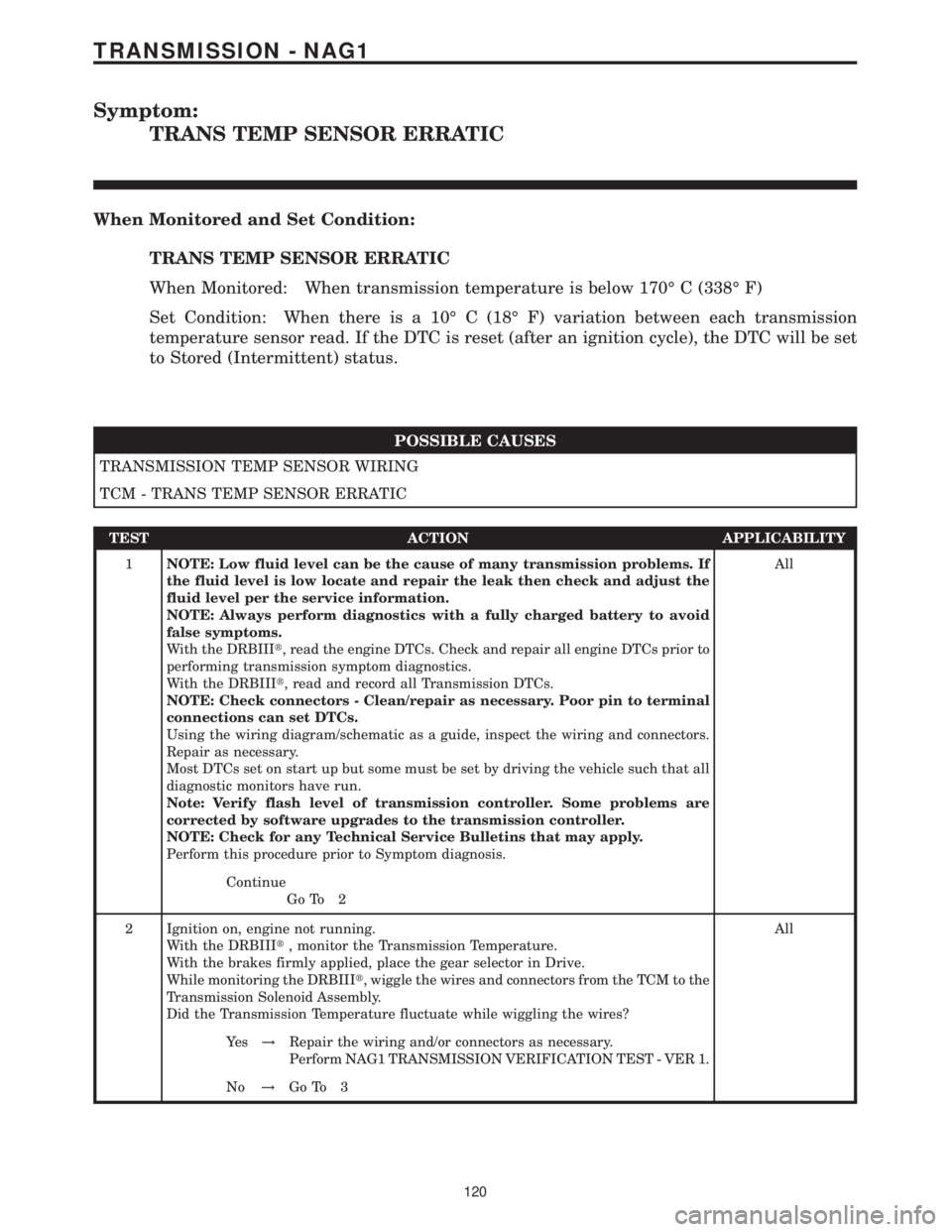
Symptom:
TRANS TEMP SENSOR ERRATIC
When Monitored and Set Condition:
TRANS TEMP SENSOR ERRATIC
When Monitored: When transmission temperature is below 170É C (338É F)
Set Condition: When there is a 10É C (18É F) variation between each transmission
temperature sensor read. If the DTC is reset (after an ignition cycle), the DTC will be set
to Stored (Intermittent) status.
POSSIBLE CAUSES
TRANSMISSION TEMP SENSOR WIRING
TCM - TRANS TEMP SENSOR ERRATIC
TEST ACTION APPLICABILITY
1NOTE: Low fluid level can be the cause of many transmission problems. If
the fluid level is low locate and repair the leak then check and adjust the
fluid level per the service information.
NOTE: Always perform diagnostics with a fully charged battery to avoid
false symptoms.
With the DRBIIIt, read the engine DTCs. Check and repair all engine DTCs prior to
performing transmission symptom diagnostics.
With the DRBIIIt, read and record all Transmission DTCs.
NOTE: Check connectors - Clean/repair as necessary. Poor pin to terminal
connections can set DTCs.
Using the wiring diagram/schematic as a guide, inspect the wiring and connectors.
Repair as necessary.
Most DTCs set on start up but some must be set by driving the vehicle such that all
diagnostic monitors have run.
Note: Verify flash level of transmission controller. Some problems are
corrected by software upgrades to the transmission controller.
NOTE: Check for any Technical Service Bulletins that may apply.
Perform this procedure prior to Symptom diagnosis.All
Continue
Go To 2
2 Ignition on, engine not running.
With the DRBIIIt, monitor the Transmission Temperature.
With the brakes firmly applied, place the gear selector in Drive.
While monitoring the DRBIIIt, wiggle the wires and connectors from the TCM to the
Transmission Solenoid Assembly.
Did the Transmission Temperature fluctuate while wiggling the wires?All
Ye s!Repair the wiring and/or connectors as necessary.
Perform NAG1 TRANSMISSION VERIFICATION TEST - VER 1.
No!Go To 3
120
TRANSMISSION - NAG1
Page 2287 of 2305
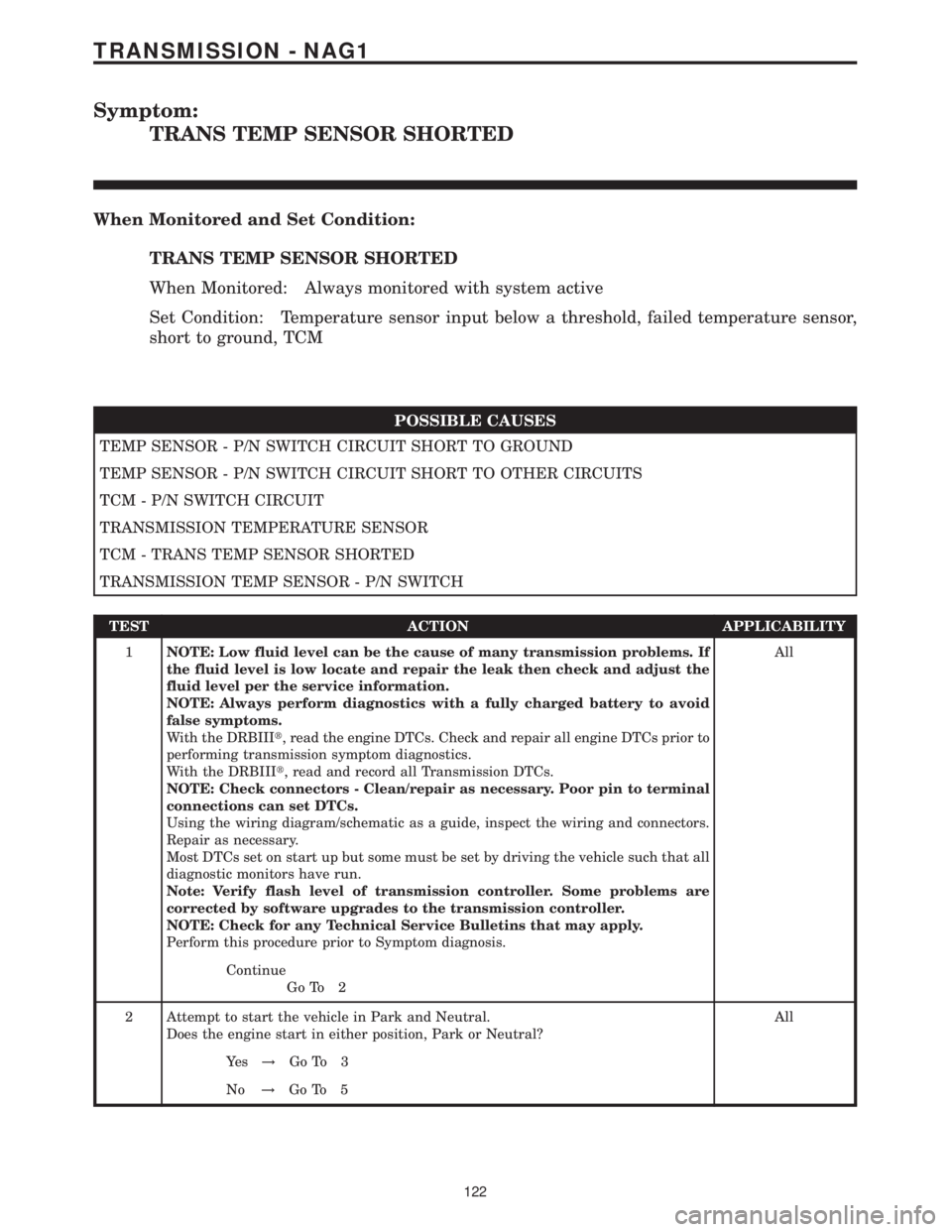
Symptom:
TRANS TEMP SENSOR SHORTED
When Monitored and Set Condition:
TRANS TEMP SENSOR SHORTED
When Monitored: Always monitored with system active
Set Condition: Temperature sensor input below a threshold, failed temperature sensor,
short to ground, TCM
POSSIBLE CAUSES
TEMP SENSOR - P/N SWITCH CIRCUIT SHORT TO GROUND
TEMP SENSOR - P/N SWITCH CIRCUIT SHORT TO OTHER CIRCUITS
TCM - P/N SWITCH CIRCUIT
TRANSMISSION TEMPERATURE SENSOR
TCM - TRANS TEMP SENSOR SHORTED
TRANSMISSION TEMP SENSOR - P/N SWITCH
TEST ACTION APPLICABILITY
1NOTE: Low fluid level can be the cause of many transmission problems. If
the fluid level is low locate and repair the leak then check and adjust the
fluid level per the service information.
NOTE: Always perform diagnostics with a fully charged battery to avoid
false symptoms.
With the DRBIIIt, read the engine DTCs. Check and repair all engine DTCs prior to
performing transmission symptom diagnostics.
With the DRBIIIt, read and record all Transmission DTCs.
NOTE: Check connectors - Clean/repair as necessary. Poor pin to terminal
connections can set DTCs.
Using the wiring diagram/schematic as a guide, inspect the wiring and connectors.
Repair as necessary.
Most DTCs set on start up but some must be set by driving the vehicle such that all
diagnostic monitors have run.
Note: Verify flash level of transmission controller. Some problems are
corrected by software upgrades to the transmission controller.
NOTE: Check for any Technical Service Bulletins that may apply.
Perform this procedure prior to Symptom diagnosis.All
Continue
Go To 2
2 Attempt to start the vehicle in Park and Neutral.
Does the engine start in either position, Park or Neutral?All
Ye s!Go To 3
No!Go To 5
122
TRANSMISSION - NAG1
Page 2290 of 2305
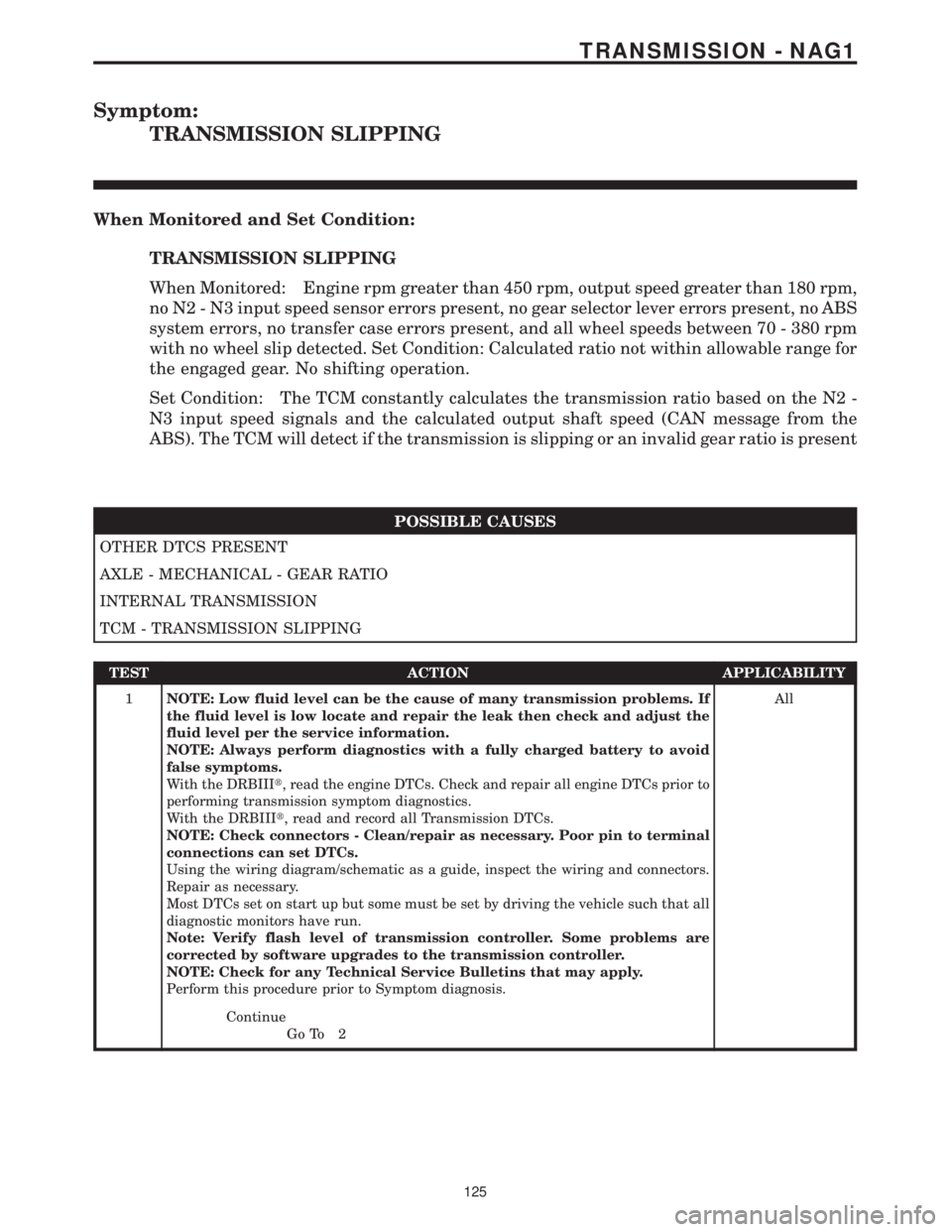
Symptom:
TRANSMISSION SLIPPING
When Monitored and Set Condition:
TRANSMISSION SLIPPING
When Monitored: Engine rpm greater than 450 rpm, output speed greater than 180 rpm,
no N2 - N3 input speed sensor errors present, no gear selector lever errors present, no ABS
system errors, no transfer case errors present, and all wheel speeds between 70 - 380 rpm
with no wheel slip detected. Set Condition: Calculated ratio not within allowable range for
the engaged gear. No shifting operation.
Set Condition: The TCM constantly calculates the transmission ratio based on the N2 -
N3 input speed signals and the calculated output shaft speed (CAN message from the
ABS). The TCM will detect if the transmission is slipping or an invalid gear ratio is present
POSSIBLE CAUSES
OTHER DTCS PRESENT
AXLE - MECHANICAL - GEAR RATIO
INTERNAL TRANSMISSION
TCM - TRANSMISSION SLIPPING
TEST ACTION APPLICABILITY
1NOTE: Low fluid level can be the cause of many transmission problems. If
the fluid level is low locate and repair the leak then check and adjust the
fluid level per the service information.
NOTE: Always perform diagnostics with a fully charged battery to avoid
false symptoms.
With the DRBIIIt, read the engine DTCs. Check and repair all engine DTCs prior to
performing transmission symptom diagnostics.
With the DRBIIIt, read and record all Transmission DTCs.
NOTE: Check connectors - Clean/repair as necessary. Poor pin to terminal
connections can set DTCs.
Using the wiring diagram/schematic as a guide, inspect the wiring and connectors.
Repair as necessary.
Most DTCs set on start up but some must be set by driving the vehicle such that all
diagnostic monitors have run.
Note: Verify flash level of transmission controller. Some problems are
corrected by software upgrades to the transmission controller.
NOTE: Check for any Technical Service Bulletins that may apply.
Perform this procedure prior to Symptom diagnosis.All
Continue
Go To 2
125
TRANSMISSION - NAG1
Page 2292 of 2305
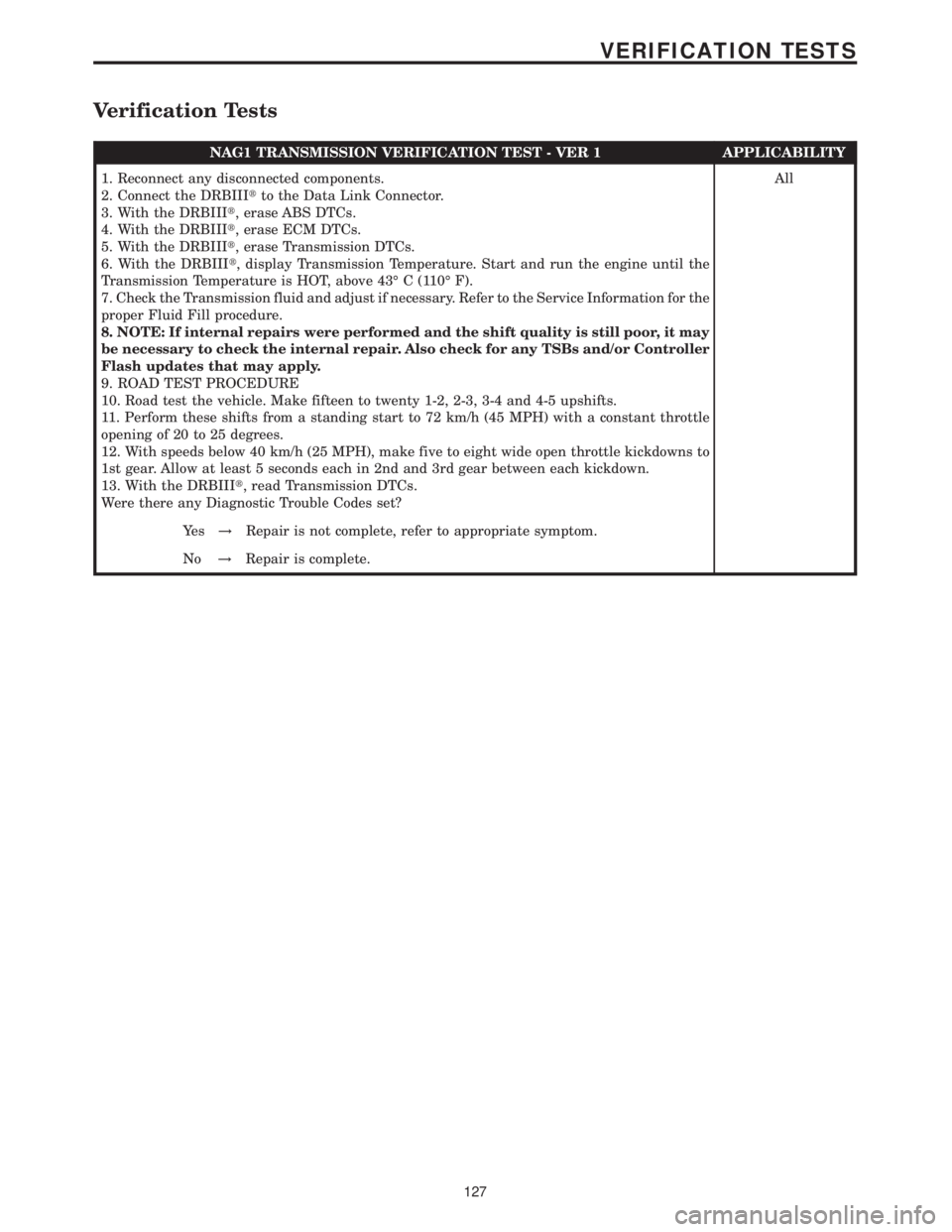
Verification Tests
NAG1 TRANSMISSION VERIFICATION TEST - VER 1 APPLICABILITY
1. Reconnect any disconnected components.
2. Connect the DRBIIItto the Data Link Connector.
3. With the DRBIIIt, erase ABS DTCs.
4. With the DRBIIIt, erase ECM DTCs.
5. With the DRBIIIt, erase Transmission DTCs.
6. With the DRBIIIt, display Transmission Temperature. Start and run the engine until the
Transmission Temperature is HOT, above 43É C (110É F).
7. Check the Transmission fluid and adjust if necessary. Refer to the Service Information for the
proper Fluid Fill procedure.
8. NOTE: If internal repairs were performed and the shift quality is still poor, it may
be necessary to check the internal repair. Also check for any TSBs and/or Controller
Flash updates that may apply.
9. ROAD TEST PROCEDURE
10. Road test the vehicle. Make fifteen to twenty 1-2, 2-3, 3-4 and 4-5 upshifts.
11. Perform these shifts from a standing start to 72 km/h (45 MPH) with a constant throttle
opening of 20 to 25 degrees.
12. With speeds below 40 km/h (25 MPH), make five to eight wide open throttle kickdowns to
1st gear. Allow at least 5 seconds each in 2nd and 3rd gear between each kickdown.
13. With the DRBIIIt, read Transmission DTCs.
Were there any Diagnostic Trouble Codes set?All
Ye s!Repair is not complete, refer to appropriate symptom.
No!Repair is complete.
127
VERIFICATION TESTS
Page 2294 of 2305
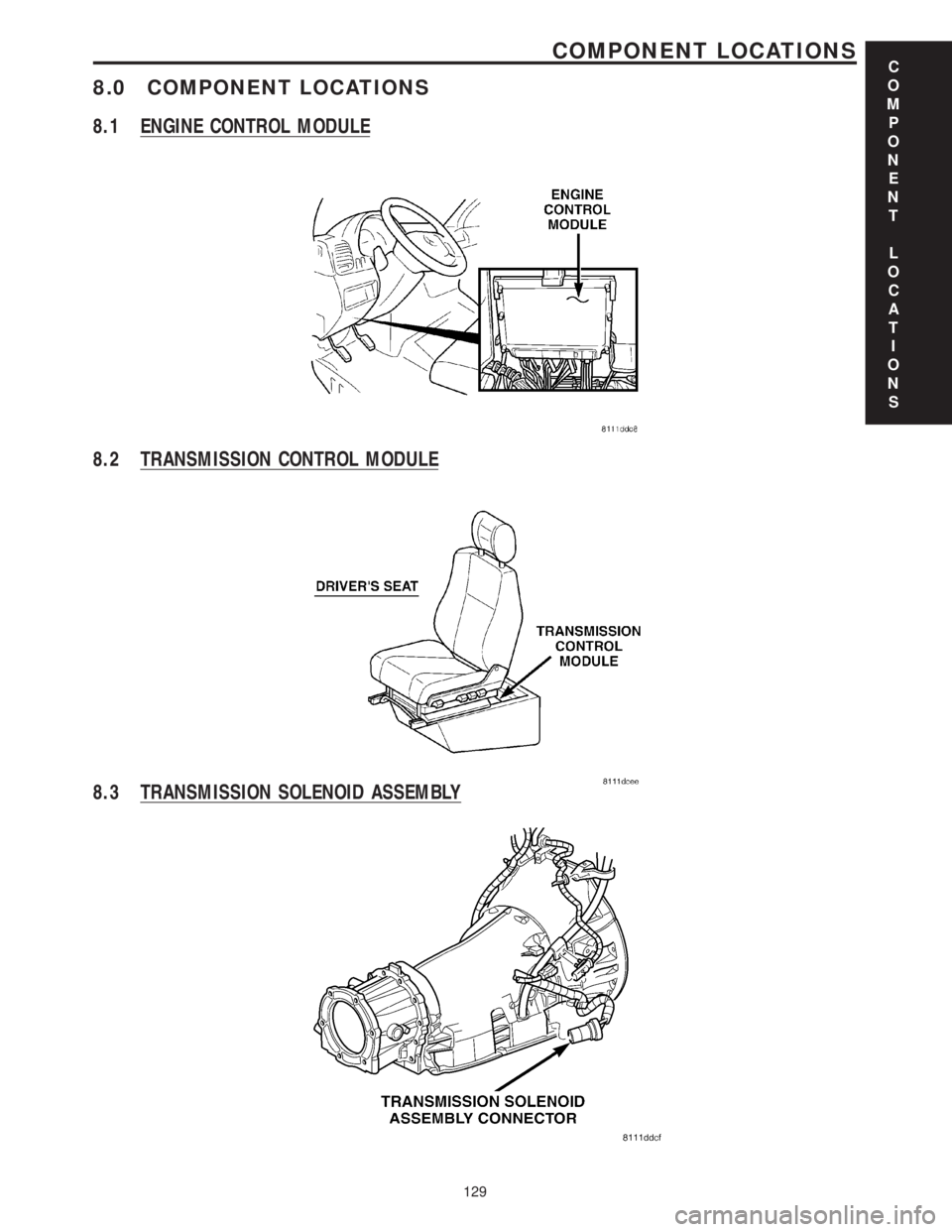
8.0 COMPONENT LOCATIONS
8.1 ENGINE CONTROL MODULE
8.2 TRANSMISSION CONTROL MODULE
8.3 TRANSMISSION SOLENOID ASSEMBLY
C
O
M
P
O
N
E
N
T
L
O
C
A
T
I
O
N
S
129
COMPONENT LOCATIONS
Page 2304 of 2305
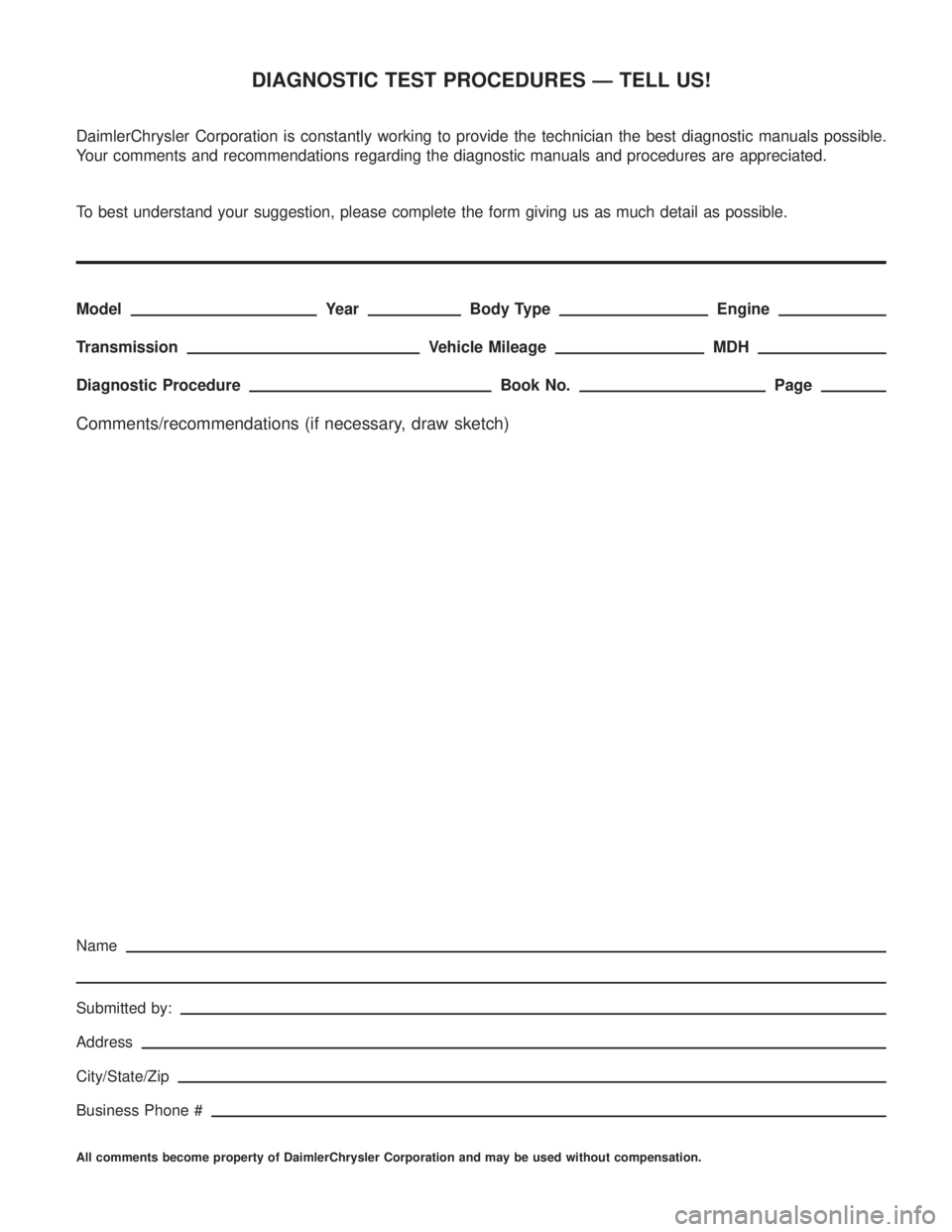
DIAGNOSTIC TEST PROCEDURES — TELL US!
DaimlerChrysler Corporation is constantly working to provide the technician the best diagnostic manuals possible.
Your comments and recommendations regarding the diagnostic manuals and procedures are appreciated.
To best understand your suggestion, please complete the form giving us as much detail as possible.
ModelYearBody TypeEngine
TransmissionVehicle MileageMDH
Diagnostic ProcedureBook No.Page
Comments/recommendations (if necessary, draw sketch)
Name
Submitted by:
Address
City/State/Zip
Business Phone #
All comments become property of DaimlerChrysler Corporation and may be used without compensation.